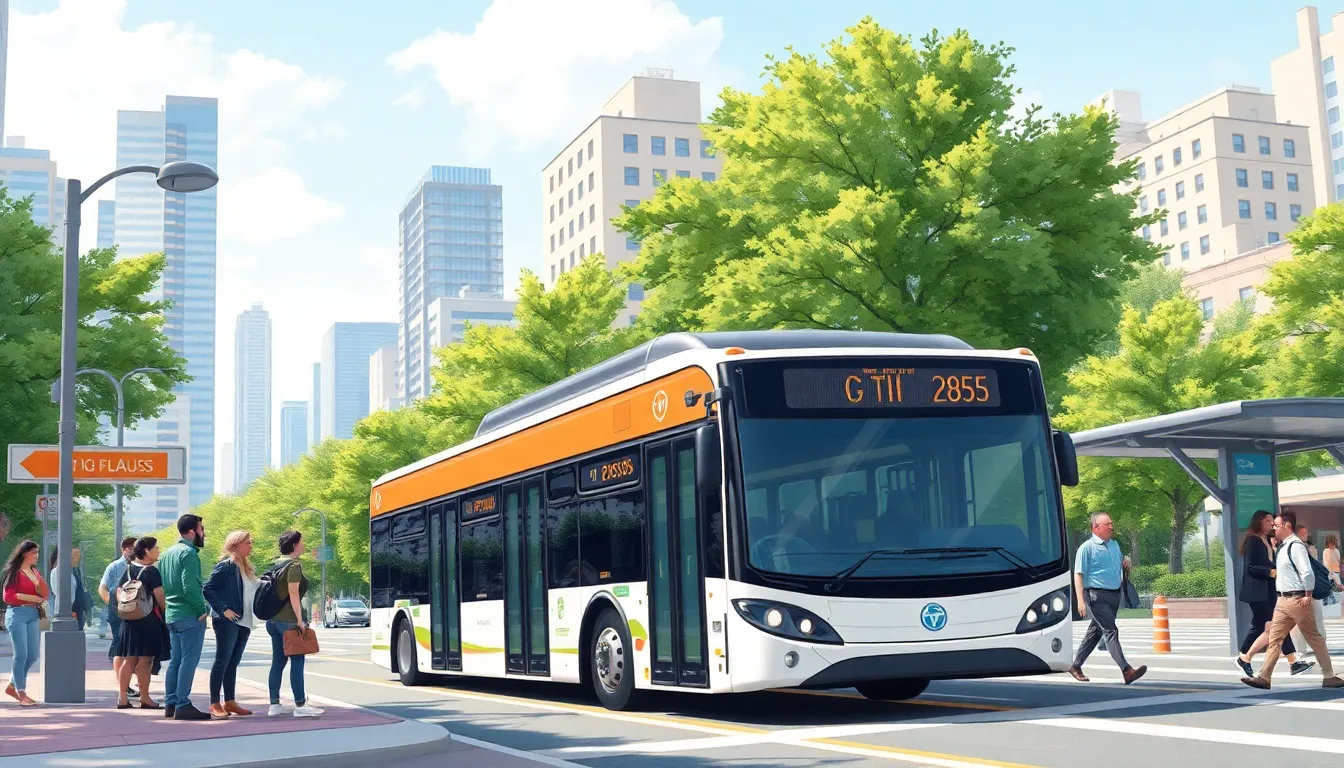Imagine a world where your daily commute doesn’t involve inhaling exhaust fumes or getting stuck in traffic jams. Electrified public transport is here to make that dream a reality. With electric buses and trams zipping through city streets, it’s time to say goodbye to the gas-guzzling giants of the past. Not only do these eco-friendly options reduce pollution, but they also make your ride smoother than your favorite playlist.
As cities embrace this electrifying shift, commuters are discovering the perks of cleaner air and quieter journeys. It’s like upgrading from a flip phone to the latest smartphone—once you go electric, there’s no going back. So buckle up and get ready to explore how electrified public transport is transforming urban travel, one charge at a time.
Table of Contents
ToggleOverview of Electrified Public Transport
Electrified public transport includes systems such as electric buses, trams, and trains operating on renewable energy. Environmental benefits play a key role in the adoption of these technologies, as they significantly reduce greenhouse gas emissions compared to fossil fuel alternatives. Urban areas benefit from lower air pollution levels, contributing to improved public health and encouraging more residents to use mass transit.
The transition to electrified systems enhances the overall commuting experience through reduced noise levels and smoother rides. Commuters often notice the difference, enjoying quieter journeys that lead to an increased quality of life in urban environments. Many cities have embraced electric buses as a means to modernize their fleets, driven by the goal of creating sustainable cities.
Funding initiatives and government incentives drive the implementation of electrified transport systems. Electric bus initiatives, for example, witness cities outgrowing their dependence on diesel models and committing to a future of sustainable transit. Data shows that regions investing in electrified transport experience long-term savings due to decreased operational and maintenance costs associated with electric vehicles.
Electric trams, commonly utilizing overhead wires or ground-level power supply systems, represent yet another component of this transformation. Cities incorporating electric tram systems observe increased ridership as reliability and efficiency improve. With advancements in battery technology, charging infrastructure also expands, allowing for greater flexibility in deployment and operation.
Data confirms that electrified public transport systems not only meet commuting needs but also align with broader environmental goals. Integrating these systems into urban infrastructure paves the way for a cleaner, more efficient future, proving that embracing electric solutions provides tangible benefits for cities and their inhabitants.
Benefits of Electrified Public Transport

Electrified public transport offers significant advantages for urban environments. With improvements in technology, cities can now experience a cleaner, more efficient commuting system.
Environmental Impact
Electrified public transport drastically reduces greenhouse gas emissions. According to the U.S. Environmental Protection Agency, transportation accounts for nearly 29% of total greenhouse gas emissions. Switching to electric vehicles lessens air pollution, which enhances public health outcomes. Citizens benefit from improved air quality due to the drop in harmful emissions. Operational noise also decreases, leading to quieter urban spaces. Many studies indicate that cities transitioning to electric buses and trams observe measurable reductions in respiratory illnesses linked to air pollution. These factors contribute to overall environmental sustainability.
Economic Advantages
Cost savings become apparent with electrified public transport systems. Electric buses typically incur lower operational and maintenance costs compared to traditional vehicles. For instance, electric buses can save around 70% on fuel costs due to lower energy prices. Governments and municipalities gain from funding initiatives and grants aimed at supporting electrification projects. A shift to electric transport results in fewer mechanical issues, translating into reduced downtime and repair expenses. Cities attract more riders as reliability improves, boosting fare revenues. These economic benefits create a more sustainable model for funding and enhancing public transport services.
Challenges in Implementing Electrified Public Transport
Implementing electrified public transport poses several challenges that cities must address to achieve successful transitions.
Infrastructure Requirements
Cities require extensive infrastructure upgrades to support electrified transport systems. Charging stations must be installed strategically throughout urban areas, ensuring accessibility for electric buses and trams. Power supply enhancement is essential for accommodating increased energy demands. Additionally, dedicated lanes for electric vehicles may improve efficiency and safety. Public transport authorities often face budget constraints, complicating infrastructure investments. Regular maintenance of charging stations emerges as a necessity to ensure reliability. Various municipalities also need to collaborate with utility companies to secure supportive frameworks for energy distribution.
Technological Barriers
Technological barriers can hinder the rapid adoption of electrified public transport solutions. Battery technology represents a critical factor, as current models need improvements in energy density and charging speed. Older fleets present compatibility issues with newer electric systems, requiring significant retrofitting or replacements. Charging infrastructure interoperability is vital to ensure smooth operations across different vehicle types and manufacturers. Public transport operations may also encounter challenges related to software and navigation systems, which require integration with existing platforms. As cities seek to embrace these advancements, overcoming technological barriers remains essential for ensuring efficient and reliable electrified public transport.
Case Studies of Electrified Public Transport Systems
Many cities have successfully adopted electrified public transport systems, showcasing the benefits of these eco-friendly technologies. These implementations highlight the advantages of electric buses, trains, and trams in reducing emissions and enhancing passenger experiences.
Successful Implementations
Los Angeles has made significant strides with its electric bus fleet. By transforming nearly 20% of its fleet to electric, the city aims to eliminate greenhouse gas emissions by 2030. Similarly, Shenzhen, China, leads globally, transitioning its entire fleet of over 16,000 buses to electric. This shift has resulted in improved air quality and reduced noise pollution. In Europe, Amsterdam’s electric tram network operates efficiently with a focus on sustainability. As cities adopt electrification, funding initiatives support these advancements, demonstrating a commitment to cleaner urban transport.
Lessons Learned
Financial planning plays a critical role in electrification success. Many cities encountered budget constraints that delayed infrastructure upgrades. Regular maintenance of charging stations has proven essential for reliability and performance. Technological compatibility also remains a challenge. Older vehicle fleets often struggle to integrate with new electric systems. Engaging in public-private partnerships has shown promise in overcoming funding issues, enabling more extensive investments. Finally, cities should prioritize community involvement when rolling out these systems, ensuring commuter needs shape electrification strategies.
Future Prospects of Electrified Public Transport
Cities worldwide foresee advancements in electrified public transport, promising extensive environmental and operational improvements. Electric buses and trams demonstrate substantial reductions in greenhouse gas emissions, which comprise nearly 29% of overall transportation emissions. Improved air quality directly correlates with enhanced public health, leading to fewer respiratory illnesses resulting from air pollution.
Many urban areas will adopt advanced battery technologies, enabling longer ranges and faster charging times for electric fleets. Governments increasingly back this shift with funding initiatives and incentives, driving substantial fleet modernization. For example, Los Angeles aims for a complete elimination of greenhouse gas emissions by 2030, showcasing a strong commitment to sustainable transport solutions.
Shenzhen offers a successful model by transitioning its entire 16,000-bus fleet to electric, achieving notable reductions in pollution levels. Enhanced reliability and efficiency in electric trams lead to increased ridership, attracting more commuters to use public transport. Financial planning serves as a critical element in ensuring the continuous growth of electrified systems, improving fare revenues for municipalities.
Regular maintenance of charging stations proves essential for keeping these new infrastructures operational. Technological compatibility challenges exist among older fleets but are being addressed as innovation continues. Collaborative efforts among public-private partnerships and community stakeholders emerge as vital strategies for successful electrification.
Cities that prioritize electrified public transport pave the way for a cleaner, more efficient future. Those planning meticulously for infrastructure upgrades and maintenance can realize tangible benefits, ultimately enhancing the quality of urban life.
The shift towards electrified public transport marks a pivotal moment in urban development. By embracing electric buses trams and trains cities can significantly reduce pollution while enhancing the commuting experience. The long-term economic and environmental benefits are clear as communities witness improved air quality and operational savings.
As technology advances and infrastructure improves the future of public transport looks promising. With successful case studies paving the way it’s evident that cities prioritizing electrification will not only foster sustainability but also elevate the quality of life for their residents. This transition is more than just a trend; it’s a necessary step towards a cleaner and more efficient urban landscape.





